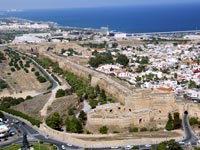
History of Famagusta North Cyprus from her Ottoman siege in 1570 to her role in 1974 Turkish intervention.
 |
the north cyprus travel guide |
 |
|
History
History of Famagusta, North CyprusFamagusta in North Cyprus is a delightful medieval walled city with architecture to rival the finest in Eastern Europe. Famagusta is still very much a working city, preserved by the hundreds of generations of Cypriots who have lived and worked here since before the time of Christ. Early History and Mystery of Famagusta, Northern CyprusThe exact age of this ancient city is uncertain, although some scholars believe it was founded in 285 BC by the Egyptian king Ptolemy. There were certainly settlements in the area a lot earlier than that, including the Bronze Age settlement of Enkomi. Indeed, the medieval walled city of Famagusta may have been built on the site of the ancient town of Arsinoe. Certainly, Famagusta benefited from the destruction of the nearby prosperous town of Salamis, when the residents probably moved from the ruined Roman settlement to Famagusta. Medieval Famagusta in North CyprusFamagusta's fortunes changed dramatically in 1291, when Christian merchants fled from the Saracens in Palestine. They came to Famagusta, where they could trade as middle-men between west and east. By 1300 AD, Famagusta was a major trading port in the eastern Mediterranean, and a city well known for its wealth and excesses. It was said that in Famagusta, merchant's daughters wore more jewels than kings at their coronations. It was also the centre for several Christian religious orders, as Cyprus was an important staging post for Crusaders heading to the Holy Land. Impressive churches still dot the town today, overlooked by the town walls. These walls were strengthened by the ruling Lusignan kings in the thirteenth century, and it was these kings who also built the most impressive church of all, the Cathedral of St Nicholas, now a magnificent mosque. Wealth and Rivalry in Famagusta, North CyprusIn 1372, the rivalry between Genoese and Venetians merchants in Famagusta was causing problems. When fighting broke out over an incident at the coronation of King Peter II, some Genoese lost both their lives and property. In revenge, the Genoese occupied parts of Cyprus and Famagusta, forcing out the traders to nearby Nicosia. The Genoese were thrown out in 1464, but the damage to trade had been done. In 1489, the Venetians moved their capital city from Nicosia to Famagusta, and they too began a massive programme of improving the town's defensive walls, adding towers and cannon posts. The Siege of Famagusta, North CyprusTheir precautions were justified when the Ottoman navy arrived in North Cyprus in 1570 and laid siege to Famagusta. Lala Mustafa Pasha tried to take the town in October 1570, but finding the fortifications too strong, decided to sit out the winter at his camp in nearby Pomodamo. Extra troops arrived in April 1571, and the siege began in earnest. By May, the Turks had managed to dig under the arsenal tower, but the plot was discovered. The defenders of Famagusta took the gunpowder destined to blow up the tower for themselves, and literally fired it back at the Turks! However, by August the citizens had run out of food, ammunition, and men fit to fight. On 1 August, 1571, the town surrendered to the Ottoman invaders. By the end of 1571, the whole of Cyprus had fallen under Ottoman rule. Ottoman Rule in FamagustaUnder Ottoman rule, Famagusta all but fell silent, the buildings within the walls neglected and the city being used as an exile home for Ottoman political prisoners. Christians were not allowed to live within the city walls, so they set up a nearby town instead, Varosha. Famagusta during 1974Famagusta was hit hard by the events of 1974. During the 1960s and 70s, Famagusta's golden beaches had been developed into a playground for the rich and famous, reflected in the modern resort hotels that lined the coast. However, the old walls of Famagusta were to play an important role once again during July and August 1974. Turkish Cypriot villagers fleeing from surrounding villages sought refuge inside the ancient city walls, entering the ancient Kaleici area via underground tunnels. The old city was finally relieved by Turkish forces on August 15, just after the Greek Cypriots had abandoned their stronghold of Varosha. After 1974, Famagusta town lay on the north side of the UN buffer zone, and the tourist trade died away. The UN buffer zone still lies just south of the city, and the whole of Famagusta could have suffered the same fate as nearby Varosha, a ghost town stuck in the buffer zone. However, the Turkish Cypriot spirit prevailed, and Famagusta simply dusted itself off and began to rebuild. Modern Famagusta, North CyprusNowadays, the new town of Famagusta lies to the south of the old walled city, known by its Turkish name of Gazimagusa. Famagusta continues to be an important port, having the deepest harbour in Cyprus, with regular exports of citrus fruits and livestock. |
|
North Cyprus quick: holidays | flights | hotels | property | kyrenia | famagusta | photos | map | weather | history | news
All text is copyrighted by Cyprus44. Photographs are copyrighted by their respective photographers.
For more information read our copyright policy, privacy policy and disclaimer.
This web page is served on 17 May 2024 at 3:32:27 PM.
![]()
Cyprus44 in other languages: Nordzypern | Chypre Nord | Severní Kypr | Северный Кипр
partner sites: goNorthCyprus Travel | Pacific Rent-A-Car | Amy Holiday Villas | other partner sites








